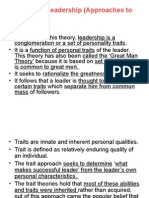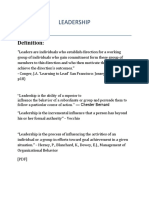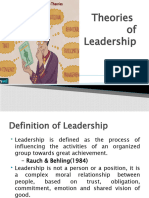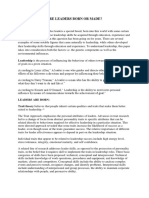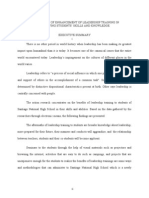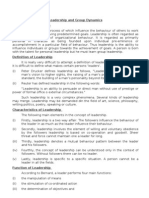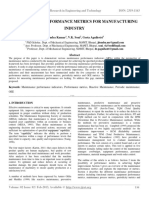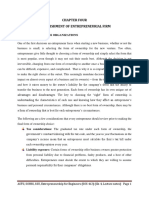Chapter 2 - Notes PDF
Uploaded by
Mesay BarekewChapter 2 - Notes PDF
Uploaded by
Mesay BarekewCHAPTER TWO
LEADERSHIP THEORIES AND STYLES
2.1 Leadership Theories
In chapter one, leadership was defined as ―the process of influencing an organized group toward
accomplishing its goals. Given this definition, one question that leadership researchers have tried to
answer over the past 100 and plus years is whether certain personal attributes or characteristics help
or hinder the leadership process. In other words, does athletic ability, height, personality, intelligence,
or creativity help a leader to influence a group? This was originally addressed in what was perhaps
the earliest theory of leadership, the Great Man theory.
2.1.1 Great Man Theory
The roots of the Great Man theory can be traced back to the early 1900s, when many leadership
researchers and the popular press maintained that leaders and followers were fundamentally
different. These led to hundreds of research studies that looked at whether certain personality
traits, physical attributes, intelligence, or personal values differentiated leaders from followers.
TO GMT:
leadership calls for certain qualities like: Charm, persuasiveness, commanding personality,
high degree of intuition
they cannot be taught or learnt
You either has them or does not have them
Leadership qualities are carried in the Genes/Something inherited/Born natural leaders/
built-in qualities/Divine design
Implications:
a. Leaders are gifts of... to mankind
b. Everyone cannot aspire to become a leader and attain greatness
c. Inborn qualities are alone necessary and sufficient (influence followers and become
successful)
d. Leadership qualities and effectiveness are independent variables (little or no influence of
nature and needs of followers, the demand of tasks and the general socioeconomic
environment)
ASTU, SoHSS, SSU, LCM (SOS372) Lecture notes, Chapter - 2 Page 1
Early studies came up with two conclusions:
First, leaders were not qualitatively different from followers; many followers were just as tall,
smart, outgoing, and ambitious as the people who were leading them.
Second, some characteristics, such as intelligence, initiative, stress tolerance, responsibility,
friendliness, and dominance, were modestly related to leadership success. In other words, people
who were smart, hardworking, conscientious, friendly, or willing to take charge were often more
successful in influencing group to accomplish its goals than people who were less smart, lazy,
impulsive, grumpy, or did not like giving orders. Having ―the right stuff in and of itself was no
guarantee of leadership success, but it did improve the odds of successfully influencing a group
toward the accomplishment of its goals.
2.1.2 Trait theory
Traits are distinctive internal or personal qualities or characteristics of an individual, it can be
Physical: like height, weight, appearance, health, etc
Personal: like self-confidence, dominance, adaptable, extroversion/sociability, originality etc
Mental: like intelligence, creativity, knowledge, technical competence etc.
A leader trait is a physical or personality characteristic that can be used to differentiate leaders
from followers.
Trait theory attempts to find traits that make a leader. That is, it is a theory, the old approach,
which focused on identifying the personal traits that differentiated leaders from followers. Trait
theory originated from an ancient theory called “Great Man” theory that assumes that “leaders
are born not made”-a belief dating back to the ancient Greeks and Romans.
The idea in trait theory was to see whether certain traits would predict the individuals who would
emerge (be identified by members of the group) as leaders.
In searching for measurable leadership traits, researchers took two approaches:
They attempted to compare the traits of those who emerged as leaders with the traits of
those who did not.
They attempted to compare the traits of effective leaders with those of ineffective leaders.
Studies that were conducted on the first category have failed to distinguish/uncover any traits
that clearly and consistently distinguish leaders from followers. Leaders as a group have been
ASTU, SoHSS, SSU, LCM (SOS372) Lecture notes, Chapter - 2 Page 2
found to be somewhat taller, brighter, more extroverted, persistent and more self-confident than
non-leaders. However, millions of people have these traits, but most of them obviously will never
attain a leadership position. In addition, many established leaders did not and do not have these
traits. (Napoleon, for example, was quite short, and Lincoln was moody and introverted.)
Interestingly enough, studies have also found that people who are too intelligent compared with
other group members do not emerge as leaders-perhaps because they are too different or too far
removed from the group.
Studies that were conducted on the second category have generally failed to isolate traits that are
strongly associated with successful leadership.
Generally, the efforts to identify universal leadership traits ran into difficulties for the following
reasons:
Not all leaders possess all the traits and many non-leaders may possess most of the traits.
It gives no guidance as to the magnitude of each trait for a person to be a leader.
No agreement has been reached as to what their relationships are to the actual instances of
leadership.
Traits tend to be a chicken-and-egg proposition i.e. Successful leaders may display traits
such as good vocabulary, education and self-confidence after they have assumed leadership
positions.
2.1.3 Behavioral leadership theory
One of the ways by which we differentiate ―good leaders from ―bad leaders is to look at
results; some leaders have a track record of getting good results across a variety of situations
whereas others seem to have difficulties getting work done through others. But another key way
we distinguish between effective and ineffective leaders is to look at what they do on a day-to-
day basis. Some leaders do a good job making decisions, providing direction, creating plans,
giving regular feedback, and getting their followers the resources they need to be successful.
Other leaders have difficulties making decisions, set vague or unclear goals, and ignore followers’
requests for equipment. Although a leader’s values, personality, and intelligence are important,
variables like these only have an indirect relationship with leadership effectiveness. Their effect
presumably comes from the impact they have on leader’s behavior, which appears to have a more
direct relationship with the leader’s ability to build teams and get results through others.
ASTU, SoHSS, SSU, LCM (SOS372) Lecture notes, Chapter - 2 Page 3
One advantage of looking at leaders in terms of behavior instead of, say, personality is that
behavior is often easier to measure; leadership behaviors can be observed whereas personality
traits, values, or intelligence must be inferred from behavior or measured with tests. Another
advantage of looking at leader behavior is that many people are less defensive about, and feel in
more control of, specific behaviors than they do about their personalities or intelligence. This
point has significant implications for developing leadership skills, a topic to be discussed later in
this chapter. However, it is vital to note that leaders with certain traits, values, or attitudes may
find it easier to effectively perform some leadership behaviors than others.
When it became evident that effective leaders did not seem to have any distinguishing traits or
characteristics, researchers tried to isolate the behaviors that made leaders effective, in other
words, rather than try to figure out what effective leaders were, researchers tried to determine
what effective leaders did, how they delegated tasks, how they communicated with and tried to
motivate their subordinates, how they carried out their tasks, and so no. This tries to answer the
questions “What do effective leaders do? What ineffective leaders don't do? How do subordinate
react emotionally and behaviorally (performance) to what the leader does? Two major dimensions
of leader behavior emerged from this body of research; one deals with how leaders get the job
done and the other deals with how leaders treat and interact with their subordinates.
a. university of Michigan study University of Michigan Studies
Through interviewing leaders and followers, researchers at the University of Michigan
identified two distinct styles of leadership, referred to as .job-centered and employee -
centered.
The job-centered leader practices close supervision on the subordinates’ performance. This
leader relies on coercion, reward, and legitimate power to influence the behavior and
performance of followers.
The employee-centered leader believes in delegating authority and supporting followers in satisfying
their needs by creating a supportive work environment. The employee centered leader is concerned
with followers', their personal advancement, growth and achievement.
b. The university of OHIO study. he Ohio State Studies
These studies isolated two leadership factors, referred to as initiating structure and
consideration.
ASTU, SoHSS, SSU, LCM (SOS372) Lecture notes, Chapter - 2 Page 4
Initiating structure involves behavior in which the leader organizes and defines the relationship
in the group, tends to establish well-defined patterns and channels of communication, and spells
out ways of getting the job done.
Consideration involves behavior indicating sensitiveness to subordinates, respect their ideas and
feelings, and establishes mutual trust and friendship between the leader and the followers. In
short, the behavioral theory attempted to identify effective leader behaviors that would work in
every situation. But researchers found that leader behaviors that worked best in one situation were
not often as effective in other situations.
After identifying the two clusters of leader behavior, researchers associated them with specific
measures of leadership effectiveness. The early studies concluded that people-oriented leadership
is associated with higher job satisfaction among subordinates, as well as lower absenteeism,
grievances, and turnover. However, job performance was lower than it was for employees with
task-oriented leaders. Task-oriented leadership, on the other hand, was associated with lower job
satisfaction as well as higher absenteeism and turnover among subordinates. But this leadership
style also seems to increase productivity and team unity. College students apparently value task-
oriented instructors because they want clear course objectives and well-prepared lectures that
abode by the course objectives.
Behavioral leadership scholars initially thought that people-oriented and task-oriented
leadership were at opposite ends of a behavior spectrum. In other words, they believed that a
strong task-oriented leader was necessarily than a weak people-oriented leader. But researchers
later concluded that these styles are independent of each other. Some people are high or low on
both styles, others
With the revised assumption that leaders could be both people-oriented and task-oriented,
behavioral leadership scholars hypothesized that the most effective leaders exhibit high levels of
both types of behavior. This became known as the “hi-hi” leadership hypothesis. Effective
leaders, it was thought, should have a high people-oriented style and a high task-oriented style.
ASTU, SoHSS, SSU, LCM (SOS372) Lecture notes, Chapter - 2 Page 5
Limitations of the Behavioral Leadership Perspective:
Contemporary leadership scholars have also moved away from the behavioral perspective because
it is a universal approach. It ignores the possibility that the best leadership style may depend on
the situation. This severely limits the predictive value of the behavioral perspective, so it has
been largely set aside in favor of contingency theories of leadership.
2.1.4 The Contingency/Situational Leadership Theory
Situational leadership theory grows out of an attempt to explain the inconsistent findings about
traits and styles /behaviors. Situational theory proposes that the effectiveness of a particular style
of leader behavior depends on the situation. As situations change, different styles become
appropriate. This directly changes the idea of one best style of leadership. In other words, the
contingency/situational theory holds that appropriate leader traits or behaviors are contingent
or dependent on relevant situational characteristics.
More specifically, the contingency leadership theory states that, leadership is the result of the
interaction of:
Leaders: behavior and competence
Followers: behavior and competence
Situations: situational variables such as job characteristics, organizational policies,
leaders member relations (the extent to which a leader has the support of group members),
position power (the amount of power that the organization gives the leader to accomplish
necessary tasks).
Fiedler’s Contingency Theory:
The first comprehensive contingency model for leadership was developed by Fred Fiedler.
Fiedler’s contingency theory of leadership proposes that effective group performance depends on
the proper match between the leaders’ style of interacting with his or her style of interacting with
his or her subordinates and the degree to which the situation gives control and influence to the
leader. This theory assumes that leader’s are task-oriented or relationship-oriented, depending
upon how the leaders obtain their primary need gratification. Task-oriented leaders are primarily
gratified by accomplishing tasks and getting work done. Relationship-oriented leaders are
primarily gratified by developing good, comfortable interpersonal relationships. Accordingly, the
effectiveness of both types of leaders depends on the favorableness of their situation.
ASTU, SoHSS, SSU, LCM (SOS372) Lecture notes, Chapter - 2 Page 6
2.1.5 Charismatic, Transactional and Transformational Leadership Theories
i. Charismatic Leadership Theory
Charismatic leadership theory says that followers make attributions of heroic or extraordinary
leadership abilities when they observe certain behaviors. Studies on charismatic leadership have
been directed at identifying those behaviors that differentiate charismatic leaders from their non
charismatic counter parts.
Several authors have attempted to identify characteristics of the charismatic leader. For example
some indentified that extreme confidence, dominance, and strong convictions as behaviors of
charismatic leaders. Still others identified that charismatic leaders have compelling vision or
sense of purpose; they could communicate that vision in or sense of purpose; demonstrated
consistency and focus in the pursuit of their vision; and they know their strengths and capitalized
on them.
Key characteristics of Charismatic Leaders
1. Self –Confidence: They have complete confidence in their judgment and ability.
2. Vision: This is an idealized goal that proposes a future better than the status quo. The greater
the disparity between this idealized goal and the status quo, the more likely that followers will
contribute extra ordinary vision to the leader.
3. Ability to articulate the vision: leaders are able to clarify and state the vision in terms that
are understandable to others. This articulation demonstrates an understanding of the
follower’s need, and hence, acts as a motivating factor.
4. Strong convictions about the vision: charismatic leaders are perceived as being strongly
committed, and willing to take on a high personal risk, incur high costs and engage in self
sacrifice to achieve their vision.
5. Behavior that is out of the ordinary: Those with charisma engage in behavior that is
perceived as being novel, unconventional, and counter to norms. When successful, these
behaviors evoke surprise and admiration in followers.
6. Perceived as being a change agent: Charismatic leaders are perceived as change agents of
radical change rather than as caretakers of the status quo.
7. Environment sensitivity: Charismatic leaders are able to make a realistic assessment of the
environmental constraints and resources needed to bring about change.
ASTU, SoHSS, SSU, LCM (SOS372) Lecture notes, Chapter - 2 Page 7
Attention has recently focused on trying to determine how charismatic leaders actually influence
followers. The process begins by the leader articulating an appealing vision. The vision provides a
sense of continuity for followers by linking the present with a better future for the organization.
The leader then communicates high performance expectations and expresses confidence that
followers can attain them. This enhances followers self esteem and self-confidence. Next, the
leader conveys, through words and actions, a new set of values, and, by his or her behavior, set of
an example for followers to imitate. Finally, charismatic leader make self sacrifices and engages
in unconventional behavior to demonstrate courage and convictions about the vision.
What can you say on the effect of charismatic leader on his or her follower? An increasing body
of research shows impressive correction between charismatic leadership and high performance
and satisfaction among followers. People working with charismatic leaders are motivated to exert
extra work effort and, because they like their leader, express greater satisfaction.
If charisma is desirable, can people learn to be charismatic leaders? Or are charismatic leaders
born with their qualities? While some people think charisma cannot be learned, most experts
believe individuals can be trained to exhibit charismatic behaviors and can thus enjoy the benefits
that accrue to being labeled “a charismatic leader”.
ii. Transformational versus Transactional Leadership
Transformational leadership is different from transactional leadership. Transactional leadership is
“managing” – helping organizations achieve their current objectives more efficiently, such as
linking job performance to valued rewards and ensuring that employees have the resources
needed to get the job done. The contingency and behavioral theories described earlier adopt the
transactional perspective because they focus on leader behaviors that improve employee
performance and satisfaction.
In contrast, transformational leadership is about “leading “- changing the organization’s strategies
and culture so that they have a better fit with the surrounding environment. Transformational
leaders are agents of change who energize and direct employees to a new set of corporate values
and behaviors.
ASTU, SoHSS, SSU, LCM (SOS372) Lecture notes, Chapter - 2 Page 8
Should organizations have transactional or transformational leaders? The answer is that they need
both. Transactional leadership improves organizational efficiency, whereas transactional
leadership steers organizations on a better course of action. Unfortunately, too many leaders get
trapped in the daily managerial activities that represent transactional leadership. They lose touch
with the transformational aspect of effective leadership. Without transformational leaders,
organizations stagnate and eventually become seriously misaligned with their environments.
iii. Transformational versus Charismatic Leadership
Another important distinction is between transformational and charismatic leadership. These
concepts have generated some controversy and confusion among leadership experts. A few
writers use the words “Charisma” and “transformational” leadership interchangeably, as if they
have same meaning. However, charismatic leadership differs from transformational leadership.
As we have seen earlier, “Charisma” is a form of interpersonal attraction whereby followers
develop a respect for and trust in the charismatic individual. Charismatic leadership therefore
extends beyond behaviors to personal traits that provide referent power over followers.
Transformational leadership, on the other hand, is mainly about behaviors that people use to lead
the change process.
It is important to note that all transformational leaders are charismatic, but not all
charismatic leaders are transformational. Transformational leaders are charismatic because
they are able to articulate a compelling vision of the future and form strong emotional attachments
with followers. However, this vision and these relationships are aligned with followers’ value
systems and help them get their needs met. Charismatic leaders are those who are not
transformational can convey a vision and form strong emotional bonds with followers, but they do
so in order to get their own (i.e., the leader’s) needs met.
Elements of Transformational Leadership:
There are several descriptions of transformational leadership, but most include four elements:
Creating a strategic vision, communicating the vision, modeling the vision, and building
commitment toward the vision.
ASTU, SoHSS, SSU, LCM (SOS372) Lecture notes, Chapter - 2 Page 9
Creating a strategic Vision: Transformational leaders are the brokers of dreams. They shape a
strategic vision of a realistic and attractive future that bonds employees together and focuses
their energy towards support organizational goal.
Communicating the Vision: If vision is the substance of transformational leadership, then
communicating that vision will is the process. Effective leaders are able to communicate
meaning and elevate the importance of the visionary goal to the employees. They frame
messages around a ground purpose with an emotional appeal that captivates employees and
others corporate stakeholders.
Modeling the Vision: transformational leaders not only talk about a vision, they enact it.
Transformational leaders are reliable and persistent in their actions.
Building commitment toward the vision: transforming a vision into reality requires employee
commitment. Transformational leaders build this commitment in several ways. Their words,
symbols, and stories build a contagious enthusiasm that energizes people to do the vision as their
own. Leaders demonstrate a “Can do” attitude by enhancing their vision and staying on course.
Their persistence and consistency reflect an image of honesty, trust and integrity. Finally, leaders
build commitment by involving employees in the process of shaping the organization’s vision.
The study of charismatic leaders indicates they are not limited by age or situation Individuals such
as John F. Kennedy, Winston Churchill, Mikhail Gorbachev, and Walt Disney possessed
exceptional qualities and an attractiveness that enabled them to play a vital role in creating change
in their respective countries or fields of endeavor. Mahatma Gandhi, Nelson Mandela, Marthin
Luther King, Jr., Mao Zedong and others are also cited examples of charismatic leaders. On the
other hand, Steven Jobs, cofounder of Apple Computer, provides another example of how
charisma inspires others. Jobs’s impact, attraction, and inspiration when he was with the firm
were monumental.
ASTU, SoHSS, SSU, LCM (SOS372) Lecture notes, Chapter - 2 Page 10
2.2 CONCEPT AND MEANING OF LEADERSHIP STYLES
The focus on finding leadership style (behavior patterns of leaders) is on the relationship between
leaders’ action and the reaction of subordinates emotionally and behaviorally. A manager’s
leadership style is composed of three parts:
How the manager chooses to motivate subordinates: Motivation approach can be
positive (like Responsibility, Recognition, Praise, Security, Monetary Rewards) or negative (like
Threats, Coercion, Fines, Suspensions, Termination)
His/her decision-making style: the degree of decision-making authority the manager
grants to subordinates.
His/her areas of emphasis (orientation) in the work environment: Task orientation,
employee orientation.
Based on the above points there are three types of leadership styles: Autocratic, Democratic,
and Laissez-faire.
i. Authoritarian (Autocratic) Leadership Style:
It is closely associated with the classical approach to management. The manager who follows this
style is dogmatic and leads by the ability to withhold or give rewards and punishment, i.e.
motivation is through incentives and fear. In this style, decision-making is solely by the manager,
in other words, the leader retains all authority and responsibility. In the extreme case, the manager
makes the decision and announces it to the work group. There is no opportunity for input into the
decision-making process by the subordinates and communication is primarily downward.
Variations of this approach find the manager making the decision and then “Selling” it to
employees or making the decision and allowing the group the opportunity to ask questions. The
autocratic leader is task-oriented and places little value on showing consideration to
subordinations as a leadership technique. The Autocratic manager uses Theory X assumption as
his philosophical base for leadership. There are situations where managers are compelled/ forced
to use this leadership style. Some are:
When there is a need to influence subordinates in favor of organizational objectives which has
an effect on individuals.
When subordinates are new, they need to be directed.
ASTU, SoHSS, SSU, LCM (SOS372) Lecture notes, Chapter - 2 Page 11
When the situation calls for unilateral or one-sided and independent decision-making –
perhaps there is no enough time for quality input from subordinates or the subordinates may
lack information.
Limitations:
Employees’/subordinates’ ideas will not be used to solve organizational problems, which in
some cases subordinates may have better ideas than the superior about a particular problem.
Subordinates would not be motivated, i.e. It may suppress individual initiative
Poor implementation of decisions
ii. Democratic/Participative Leadership Style:
In this leadership style, the manager involves subordinates in making organizational decisions,
shares problems with them and shares authority to reach a decision. Subordinates take part in the
decision-making process through consultation. The leader delegates a great deal of authority
while retaining ultimate responsibility. Active two-way communication (upward and downward)
exists. The democrat leader uses Theory Y assumption as his/her philosophical base for
leadership.
Limitations:
Subordinates may be too involved to influence the manager even when there is no need.
The manager may not be able to influence the subordinates to the extent needed.
However, the major advantage of this leadership style is that, it enhances personal commitment
through participation. The advantages of democratic leadership style are the disadvantages of the
autocratic leadership style after we make them opposite.
iii. Laissez-Faire/Free-Rein Leadership Style:
In this leadership style, leaders generally give the group complete freedom, provide the necessary
materials, participate only to answer questions, and avoid decision-making whenever possible.
The leader either sets limits and the followers work out their own problems, or the individuals set
their own goals. In this style, leaders depend largely on subordinates to set their own goals and the
means of achieving them, and they see their role as one of aiding the operations of followers by
furnishing them information and acting primarily as a contact with the groups external
environment, i.e. the leader’s role is to serve as a logistics specialist or representative of the group
to outside groups. The leader denies responsibility and abdicates authority to the group.
ASTU, SoHSS, SSU, LCM (SOS372) Lecture notes, Chapter - 2 Page 12
The application of Laissez-Faire style can be found with individuals or groups that the manager
views as being knowledgeable, independent, or motivated. Additionally, if the work group is
composed of high achievers, or is highly research oriented, this style has potential benefits.
Primarily horizontal communication among peers exists.
Limitations:
Group may drift aimlessly in the absence of direction from leader.
It may make things out of control.
Advantages:
It gives quite freedom for subordinates
It gives much responsibility and self guidance for subordinates
It permits self-starters to do things as they see fit without leader
Situational Leadership style: The situational leadership style states that for a manager to be
democrat, autocratic or laissez-faire, situations force him/her.
2.3. Leadership Skills and Competencies
One of the reason any person can improve his or her leadership effectiveness is that part of
leadership involves skills, and skills can be practiced and developed. A further advantage of
looking at leadership skills is that most people are less defensive about deficits in skills (which
can be improved) than about suggested deficits in, say, personality. Therefore, the rationale for
this subsection (discussing leadership skills and competencies) is that certain skills do contribute
to leadership effectiveness, and they can be learned.
2.3.1. Basic Leadership Skills
Basic leadership skills includes: learning from experience, communication, listening,
assertiveness, providing constructive feedback, guidelines for effective stress management,
building technical competence, building effective relationships with superiors, building effective
relationships with peers, setting goals, punishment and conducting meetings.
Learning from Experience
Leadership practitioners can enhance the learning value of their experiences by (a) from creating
opportunities to get feedback, (b) taking a 10 percent stretch, (c) learning from others, (d) keeping
a journal of daily leadership events, and (e) having a developmental plan.
ASTU, SoHSS, SSU, LCM (SOS372) Lecture notes, Chapter - 2 Page 13
Communication
The quality of a leader’s communication is positively correlated with subordinate satisfaction as
well as with productivity and quality of services rendered. Effective communication skills are also
important because they provide leaders and followers with greater access to information relevant
to important organizational decisions.
Communication is best understood as a process beginning with an intention to exchange certain
information with others. That intention eventually takes form in some particular expression,
which may or may not adequately convey what was intended.
The next stage is reception. Just as with a weak or garbled radio signal or malfunctioning
antenna, what is received is not always what was sent. Reception is followed by interpretation.
Finally, it is not enough merely to receive and interpret information; other’s interpretations may
or may not be consistent with what was intended at the outset. Therefore, it always helps to have a
feedback loop to assess any communication’s overall effectiveness.
Listening
A systems view of communication emphasized that effectiveness depends up on both transmitting
and receiving information. It may be more general topic of communication.
Good leaders and followers recognize the value of two-way communication. Listening to others is
just as important as expressing oneself clearly to them. People in leadership roles are only as good
as the information they have, and much of their information comes from waiting and listening to
what goes on around them.
At first, it may seem strange to describe listening as a skill. Listening may seem like an automatic
response to things being said, not something one practices to improve, like free throws. However,
the best listeners are active listeners, not passive listeners. In passive listening, someone may be
speaking but the receiver is not focused on understanding the speaker. Instead, the receiver may
be thinking about the next thing he will say or how bored he is in listening to the speaker. In
either case, the receiver is not paying attention to what the sending is saying. To truly get the
fullest meaning out of what someone else says, one needs to practice active listening. Individuals
who are listening actively exhibit a certain pattern of nonverbal behaviors, do not disrupt the
sender’s message, try to put the sender’s message into their own words, and scan the sender for
ASTU, SoHSS, SSU, LCM (SOS372) Lecture notes, Chapter - 2 Page 14
various nonverbal signals. Knowing what nonverbal signals to send and correctly interpreting the
sender’s nonverbal signals are the knowledge component of listening skills. One’s nonverbal
signals are the behavioral component, and how well one can paraphrase a sender’s message
makes up the evaluative component of listening skills.
In addition to helping one understand others better, active listening is a way to visibly
demonstrate that one respects others. People, particularly those with high self-monitoring scores,
can often sense when others are not truly paying attention to what they are saying.
Followers will quickly decide it is not worth their time to give their leader information if they
perceive that they are not being listened to. Leaders may do the same. To avoid turning off others,
leaders and followers can improve their active listening skills in a number of ways. Some of these
tips to improve active listening skills include: Model nonverbal signals associated with active
listening or demonstrate nonverbally that you are listening, actively interpret the sender, be
aware of the sender’s nonverbal behaviors, and avoid becoming defensive.
Assertiveness
What is assertive behavior? And what are assertiveness skills? Because individuals exhibiting
assertive behavior are able to stand up for their own rights (or their group’s rights) in a way that
also recognizes the concurrent right of others to do the same. Like the skills already discussed,
assertiveness skills also have knowledge, behavior, and evaluative components. The behavioral
component of assertiveness skills was mentioned already- it involves standing up for one’s own
or the group’s right in a constructive, non-hostile way. The knowledge component of
assertiveness skills concerns knowing where and when not to behave assertively. People who are
overly assertive may be perceived as aggressive and often may ―win the battle but lose the war.
Finally, the evaluative component comes into play when individuals are successful (or
unsuccessful) in standing up for their own or their group’s rights and continually working in an
effective manner with others.
Providing Constructive Feedback
Giving constructive feedback involves sharing information or perceptions with another about the
nature, quality, or impact of that person’s behavior. It can range from giving feedback pertaining
to specifically to a person’s work (i.e., performance feedback) to impressions of how aspects of
ASTU, SoHSS, SSU, LCM (SOS372) Lecture notes, Chapter - 2 Page 15
that person’s interpersonal behavior may be pervasively affecting relationships with others.
Getting helpful feedback is essential to a subordinate’s performance and development. Without
feedback, a subordinate will not be able to tell whether she’s doing a good job or whether or not
her abrasiveness is turning people off and hurting her chances for promotion. And it’s not just
subordinates who need constructive feedback to learn and grow. Peers may seek feedback from
peers, and leaders may seek feedback from subordinates.
Besides fostering growth, effective supervisory feedback also plays a major role in building
morale. In many ways, the development of good feedback skills is an outgrowth of developing
good communication, listening, and assertiveness skills. Giving good feedback also depends on
sending the proper nonverbal signals and trying to detect emotional signals from whoever may be
receiving the feedback. In addition, giving good feedback depends on being somewhat assertive
in providing it, even when it may be critical of a person’s performance or behavior. Although
feedback skills are related to communication, listening, and assertiveness skills, they are not the
same thing. Someone may have good communication, listening, and assertiveness skills but poor
feedback skills.
Although there are a number of reasons why leaders are hesitant to provide both positive and
negative feedback, leaders need to keep in mind that followers, committee members, or team
members will perform at a higher level if they are given accurate and frequent feedback. It is
difficult to imagine how work-group or team performance could improve without feedback.
Positive feedback is necessary tell followers they should keep doing what they are doing well, and
negative feedback is needed to give followers or team member’s ideas on how to change other
behavior to improve their performance.
Guidelines for Effective Stress Management
The term stress refers to the whole process by which we appraise and respond to events that
challenge or threaten us. These responses usually include increased levels of emotional arousal
and changes in physiological symptoms, such as increases in perspiration and heart rates,
cholesterol levels, or blood pressure. Stress often occurs in situations that are overly complex,
demanding, or unclear. Stressors are those specific characteristics in individuals, tasks,
organization, or the environment that pose some degree of threat or challenge to people.
ASTU, SoHSS, SSU, LCM (SOS372) Lecture notes, Chapter - 2 Page 16
However, the degree of stress associated depends on the degree of the stress tolerance levels and
prior experience with the stressor in question. Similarly, it is important to realize that stress is in
the eyes of the beholder-what one person may see as challenging and potentially rewarding,
another may see as threatening and distressful.
Building Effective Relationships with Superiors
There are a number of advantages to having a good working relationship with superiors. First,
superiors and followers sharing the same values, approaches, and attitudes will experience less
conflict, provide higher levels of mutual support, and be more satisfied with superior-follower
relationships than superiors and followers having poor working relationships. Relatedly,
individuals having good superior-follower relationships are often in the superior’s in-group and
thus are more likely to have a say in the decision-making process, be delegated interesting tasks,
and have the superior’s support for career advancement. Second, followers are often less satisfied
with their superior and receive lower performance appraisal ratings when superior-follower
relationships are poor. Another advantage of having a good working relationship with superior
seem clear, one might mistakenly think that followers have little, if any, say in the quality of the
relationship. In other words, followers might believe their relationships with superiors are a
matter of luck; either the follower has a good superior or a bad one, or the superior just happens to
like or dislike the follower, and there is little if anything the follower can do about it. However,
the quality of a working relationship is not determined solely by the superior, and effective
subordinates do not limit themselves to a passive stance toward superiors. Effective subordinates
have learned how to take active steps to strengthen the relationship and enhance the support they
provide their superior and the organization. This can be made through two things: Understanding
the superior’s world and adapting to the superior’s style.
Building Effective Relationships with Peers
No man/woman is an island, it is said, and perhaps no worker in today’s organizations can survive
alone. Virtually everyone needs co-worker assistance or resources at one time or another. Along
these lines, some researchers have maintained that one of the fundamental requirements of
leadership effectiveness is the ability to build strong alliances with others, and groups of peers
generally wielded more influence( and can get more things done) than individuals working
separately.
ASTU, SoHSS, SSU, LCM (SOS372) Lecture notes, Chapter - 2 Page 17
Similarly, investing the time and effort to develop effective relationships with peers not only has
intermediate dividends but also can have long-term benefits if a peer ends up in a position of
power in the future.
Many times leaders are selected from among the members of a group, committee, club, or team
and, having previously spent time developing a friendly rather than an antagonistic relationship
with other work group members, will lay the groundwork for building effective relationship with
superiors and becoming a member of superiors’ in-groups.
Setting goals
Setting goals and developing plans of action to attain them are important for individuals and for
groups. For example, the purpose or goal is often the predominant norm in any group.
Punishment
In an ideal world, perhaps everyone would be dependable, achievement oriented, and committed
to the organization’s goals. The fact is, however, that leaders sometimes will need to deal with
followers who are openly hostile or insubordinate, create conflicts among co-workers, do not
work up to standards, or openly violate important rules or polices. In such cases leaders may need
to administer punishment to change the follower’s behavior.
Of all the different aspects of leadership, few are as controversial as punishment. Some of the
primary reasons for this controversy stem from myths surrounding the use of punishment, as well
as the lack of knowledge regarding the effects of punishment on followers’ motivation,
satisfaction, and performance. A leader has to develop the skill on how to properly and effectively
administer punishment in a way that helps the follower to change his/her behavior and thereby
contributes to organizational effectiveness.
Conducting Meetings
Meetings are a fact of organizational life. It is difficult to imagine a leader who could (or should)
avoid them, particularly when groups, committees, or teams have high levels of task or lateral
interdependence. Well-planned and well-lead meetings are a valuable mechanism for
accomplishing diverse goals and are an important way of exchanging information and keeping
open lines of communication within and between work groups or volunteer organizations.
Although meetings may have many advantages, they also cost time and money.
ASTU, SoHSS, SSU, LCM (SOS372) Lecture notes, Chapter - 2 Page 18
Furthermore, unnecessary or inefficient meetings can be frustrating and are often a source of
dissatisfaction for participants. Given the investment of time and energy meetings require, leaders
have a responsibility to make them a s productive as possible.
ASTU, SoHSS, SSU, LCM (SOS372) Lecture notes, Chapter - 2 Page 19
You might also like
- LEADERSHIP THEORIES AND STYLES - Supplementary Notes...No ratings yetLEADERSHIP THEORIES AND STYLES - Supplementary Notes...23 pages
- Traditional Theories and Approaches To Leadership50% (2)Traditional Theories and Approaches To Leadership28 pages
- Leadership: The Ability To Influence A Group Toward The Achievement of GoalsNo ratings yetLeadership: The Ability To Influence A Group Toward The Achievement of Goals35 pages
- Transformational Leadership (Final Modified)No ratings yetTransformational Leadership (Final Modified)18 pages
- Leadership (Trait Theory and Behavioral Theories)No ratings yetLeadership (Trait Theory and Behavioral Theories)36 pages
- Trait and Behavioral Theories of LeadershipNo ratings yetTrait and Behavioral Theories of Leadership6 pages
- Good Morning: Submitted By:-Gunjan Batra (811) Aastha Kesar (801) MBA Ist YearNo ratings yetGood Morning: Submitted By:-Gunjan Batra (811) Aastha Kesar (801) MBA Ist Year57 pages
- Chapter 2 Traits Behavior and RelationshipNo ratings yetChapter 2 Traits Behavior and Relationship16 pages
- Week 20 - Individual Differences - 2017No ratings yetWeek 20 - Individual Differences - 201725 pages
- Leadership Planing and Emotional IntellegenceNo ratings yetLeadership Planing and Emotional Intellegence31 pages
- The Use of The Leopold Matrix in Carrying Out TheNo ratings yetThe Use of The Leopold Matrix in Carrying Out The13 pages
- 2021 Curriculum For A CCT in Anaesthetics v1.3No ratings yet2021 Curriculum For A CCT in Anaesthetics v1.3194 pages
- Maintenance Performance Metrics For ManuNo ratings yetMaintenance Performance Metrics For Manu7 pages
- Evaluation of Programs Promoting Participatory Development and Good GovernanceNo ratings yetEvaluation of Programs Promoting Participatory Development and Good Governance127 pages
- African Portfolio Entrepreneurship and TNo ratings yetAfrican Portfolio Entrepreneurship and T33 pages
- Policy Design, Implementation and Evaluation - Rationale, Efficiency and Systemic ConcernsNo ratings yetPolicy Design, Implementation and Evaluation - Rationale, Efficiency and Systemic Concerns14 pages
- The Witch's Art of Incantation by Roger J. Horne 2ndNo ratings yetThe Witch's Art of Incantation by Roger J. Horne 2nd302 pages
- G.S. 26000 - One Liner Book (English Medium) Final92% (13)G.S. 26000 - One Liner Book (English Medium) Final360 pages
- Simulacro RF2 y RF3 Área e - Dino Repaso 2No ratings yetSimulacro RF2 y RF3 Área e - Dino Repaso 23 pages
- Capitalism Kritik and Answers - Emory 2024No ratings yetCapitalism Kritik and Answers - Emory 202470 pages
- John Lennon - Stand by Me Cifra Acoustic GuitarNo ratings yetJohn Lennon - Stand by Me Cifra Acoustic Guitar2 pages
- EMF Test Report: Ericsson Street Macro 6701 B261 (FCC) : Rapport Utfärdad Av Ackrediterat ProvningslaboratoriumNo ratings yetEMF Test Report: Ericsson Street Macro 6701 B261 (FCC) : Rapport Utfärdad Av Ackrediterat Provningslaboratorium13 pages
- Sailing by Rod Stewart Activities With Music Songs Nursery Rhymes CLT Com 103415No ratings yetSailing by Rod Stewart Activities With Music Songs Nursery Rhymes CLT Com 1034151 page












